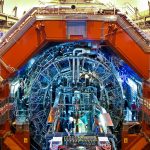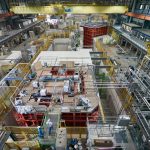When two heavy ions collide inside a particle accelerator, they produce a near-perfect fluid through which an assortment of fundamental particles swim. For scientists to accurately simulate even a tiny drop of this hot and dense subatomic brew with a classical computer, it would take longer than the age of the universe. Scientists show how quantum computing could be a game-changer in our understanding of quantum processes.
Author Archive
From DOE, Dec. 9, 2020: Computer Science Education Week is aimed at inspiring students to discover computer science activities and careers. The national laboratories, including Fermilab, are scheduled to host a number of activities to highlight The Department of Energy’s efforts, including increasing access to computer science education, building computational literacy, and growing the cyber workforce of the future.
From the CMS collaboration, Nov. 30, 2020: On Nov. 24, the CMS collaboration at CERN’s Large Hadron Collider announced the publication of the 1,000th paper in a peer-review journal, an exceptional achievement for a single experiment. Fermilab scientist Boaz Klima, CMS Publications Committee chair, is quoted.
How do the questions Galileo faced in the 17th century relate to those posed in our own era? What is our place in this vast realm of existence? How will spacetime come to an end?Symmetry writer Mike Perricone’s favorite physics books of 2020 cover an impressive span of time: from the very beginning of our universe until the very end.
From CNN, Nov. 28, 2020: The explosion of a supernova is so powerful that modern telescopes can see it half a universe away. A cautious person might wonder, “What would happen to Earth if this happened to a nearby star?” In this article, Fermilab scientist Don Lincoln discusses a paper from University of Colorado at Boulder’s Robert Brakenridge, who claims that he has found evidence here on Earth of nearby supernovae. What form does this evidence take? Ancient radioactive tree rings.
From Daily Herald, Nov. 27, 2020: Fermilab Natural Areas is restoring 500 acres of grassland near Eola Road at Fermilab to serve as a breeding habitat for several endangered and threatened bird species that do not use tallgrass prairies or woodlands, such as the upland sandpiper, bobolink and Henslow’s sparrow.
From Público, Nov. 24, 2020: Homestake fue la mayor y más profunda mina de oro de de Norteamérica hasta que se cerró en 2002 tras 125 años de funcionamiento. Este remoto lugar de Dakota del Sur se convirtió oficialmente en 2007 en un laboratorio subterráneo de física fundamental, aunque ya mucho antes se habían instalado en sus profundas cavernas algunos experimentos, incluido uno que mereció el premio Nobel. Ahora se anuncia la nueva etapa para convertir la mina en sede del megaproyecto científico más importante de las últimas décadas en Estados Unidos, el Long-Baseline Neutrino Facility, dedicado a estudiar las partículas fundamentales llamadas neutrinos.
From Quanta Magazine, Nov. 23, 2020: Physicists plan to leave no stone unturned, checking whether dark matter tickles different types of detectors, nudges starlight, warms planetary cores or even lodges in rocks. Their efforts include the SENSEI and ADMX experiments, in which Fermilab plays a key role.
From Pesquisa, November 2020: The FAPESP scientific director shares how he encouraged behaviors that helped improve research in São Paulo. With FAPESP encouragement, researchers in Brazil have held leadership positions in international collaborations, including in a photon detection system called Arapuca. Arapuca is a technology used in Fermilab’s Short-Baseline Near Detector and a baseline technology for the international Deep Underground Neutrino Experiment, hosted by Fermilab.



